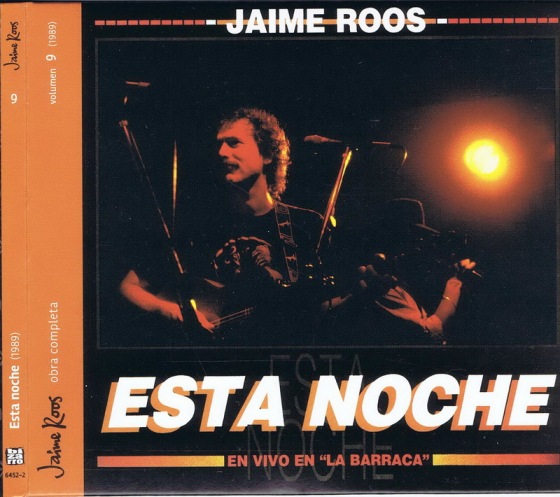Esta noche (1989)
This is Jaime’s first live album. The title song was originally included in 7 y 3. Here’s the Esta noche version, followed by the one recorded at Montevideo’s Teatro Solís in 1998, celebrating his 20 years in the music business.
Liner notes by Guilherme de Alencar Pinto: “The success of ‘Brindis por Pierrot’ meant that Jaime, since early 1986, had a calendar of about 90 annual shows. Until 1988, most of those shows were done by the Jaime Roos-Repique-Canario Luna formula. Despite the commercial success, it was widely believed that Jaime’s live shows couldn’t compare to his exceptional performance in the recording studio.
In 1989, Jaime decided to form a new backing band in order to offer a spectacle with power and musical quality that could equal that of his records. He invited his friend Hugo Fattoruso, whose presence was key to the project (both due to Hugo’s talent and their stylistic affinity). In fact, having Hugo as a permanent member of his band was a privilege for Jaime. After living in Brazil for eight years, Hugo wanted to return to Uruguay but couldn’t find solid work prospects in the country. This offer made his return possible. Jaime also recruited two members of Repique: [drummer Gustavo] Etchenique and [vocalist Rolando] Fleitas. [Vocalists Pablo “Pinocho”] Routin and [Benjamín] Medina had taken part of the Canario songs with Jaime and now would be permanent members of the new group. [Bassist] Popo Romano and [keyboardist] Diego Ebbeler were the new members (they were two of the most outstanding young musicians in the scene and Jaime had heard them in Mariana Ingold’s band). Thus La Escuelita (The Little School) was born, named after La Escuelita del Crimen, his favorite group of carnival humorists.
Soon into rehearsals, the reigning enthusiasm was so intense that Jaime proposed Orfeo to record a live album — the first in his discography — to be released by the end of the year.
The new show was launched with a series of two weekly performances — Thursdays and Fridays — at Café La Barraca (located at the intersection of Daniel Muñoz and Defensa streets), starting on November 9, 1989. That club — managed by Daniel Magnone — was becoming one of the hottest spots in the Montevideo music scene. The chosen recorded dates were only the band’s fifth and sixth live performances. The La Grabadora studio had to transport its bulky console and 16-channel recorder to La Barraca’s small dressing room. On those two nights, the musicians had to change shirts in the middle of the crowd.
Out of the two hours of the show, 44 minutes were chosen. The only mega-hit included was ‘Que el letrista no se olvide.’ Both that song (included in Canario’s 1986 album) and ‘Piropo’ (part of a 1985 Laura Canoura album) had never been released on a Jaime album. The other songs — some better known than others — belong to several of his previous albums, except two written by others. Sung by Pinocho Routin, the version of ‘Pelota al medio’ [Routin’s studio version here] — a tribute to Jorge Lazaroff, who had passed away a few months earlier (in March of 1989) — was the song that pushed the album, remaining as one of the highlights of the group’s repertoire until 1992. In late 1989, the album was solely released on cassette and had already gone Platinum by the time a few hundred vinyl copies were released on April 1990.
The shows at La Barraca would continue until 1991 with few and brief interruptions. La Escuelita released its own album (Ahora sí!! in 1990, co-produced by Jaime). After that, the band would have significant additions: Percussionist Walter ‘Nego’ Haedo in 1990, guitarist Carlos Quintana in 1991, and five additional percussionists for A las 10 (1993-1994, the most important tour in Jaime’s career, and also the band’s farewell). The band’s increased power and cohesiveness throughout those years were the reason Jaime didn’t really considered this album, and that’s why it had never been released on CD before.”
Next: The latest batch.


Enrique – saludos desde Irlanda. Thank you for these blogs about Jaime Roos’ music. I am a great admirer of this soulful, honest and important music from a beautiful and soulful country. I didn’t know if the 4 CDs in the new batch are the same quality as the first sets, your blogs have corrected that for me.
I did buy some in Montevideo but have also been able to find them also on Amazon (muy, muy caro) or ebay (mejor precio).
Do you know why “Brindis Por Pierrot” has not been released as a standalone disc or am I missing something?
Gracias por su trabajo, Simon Leng
LikeLike
OK, Guilherme explains this clearly in his commentary to Selladas Uno, but here’s a quick summary: The ‘Brindis por Pierrot’ album only included three new songs: “Brindis por Pierrot,” “Murga de la Pica” and the new version of “Cometa de la Farola.” The other six songs had already been released on other albums. ‘Selladas Uno’ includes these three songs.
The ‘Brindis por Pierrot’ album is not included in this collection because the idea is not to repeat songs, except in the case of different versions of one song, but not the same version.
These 13 albums only include three “repeat” songs: the Estela Magnone duets included in both the ‘Mujer de sal junto a un hombre vuelto carbón’ and ‘El Puente’ albums.
I hope this clarifies things. Thanks for reading and listening!
LikeLike
Good question! Let me find out… Abrazo.
LikeLike
Thanks, that is great information. Here’s a thought for you…..is “Fuera de Ambiente” Jaime Roos’ masterpiece? To my ears it could be
LikeLike
I love ‘Fuera de Ambiente,’ but I’m not sure if it’s his masterpiece. Definitely one of his best, and unfairly underrated. It’s his only album of originals with no solos. Everything is written down. Beautiful songs. When I saw him live for the last time in 2007, my mother was on her deathbed and he kindly dedicated “Catalina” to her. I think his first masterpiece is ‘Aquello’, but I also love ‘Siempre son las cuatro’, ‘Mediocampo’ and ‘Estamos rodeados’. And ‘La Margarita’ too. But I love them all. I’m a diehard fan.
LikeLike
I look forward to hearing the next set of 4 which I ordered for a reasonable price on amazon, so they are available globally. I especially like “Vida Numero Dos” which I think is a profound piece and captures many different musical elements…some of which I have written about:
I am pro-Uruguay so probably biased but as well as great soccer players and teams the country has produced some really world class music with Opa, Ruben Rada and Jaime Roos leading the pack. Outstanding musicians.
Best wishes…
LikeLike
So… What’s your story with Uruguay? Are you English?
LikeLike
It’s a “camino largo” ; )
Email me if you like simon,leng@gmx.com
LikeLike
comma after simon…?
LikeLike
Disculpa….no. That is a typo. It is simon.leng. ayer recibi the new discs….La Margarita is going to require some study.
LikeLike
Beautiful album. I love it.
LikeLike
Pingback: #94 / NEGRITUD: Recordando a Alfonso López Domínguez | KAMIKAZE
Pingback: # 91 / Spinetta Jade 1982: el reportaje perdido | KAMIKAZE